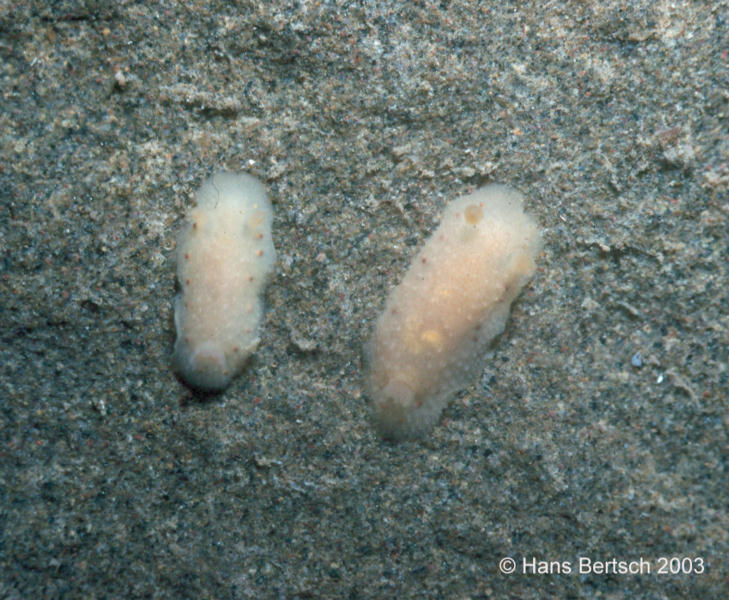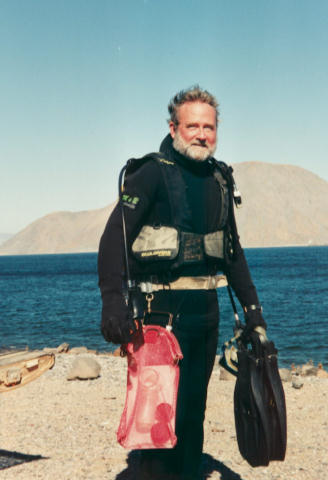 |
Cadlina sparsa
Photo courtesy of Dr. Hans Bertsch
Cadlina sparsa (Odhner, 1921)
In "Natural History of Juan Fernandez and Easter Island" (C.J.F. Skottsberg, ed., 1921), Odhner named the new genus Juanella (obviously in honor of the Juan Fernandez Islands, the type locality), establishing Juanella sparsa as its type species. Several years later, in his report on the Opisthobranchia of the 1901-1903 Swedish Antarctic Expedition, Odhner (1926: 57) synonymized Juanella with Cadlina: "...um die Gattung Juanella aufrecht zu erhalten, weshalb ich sie wieder als mit Cadlina synonym aufhebe."
It was almost 40 years until the next report of collected specimens of Cadlina sparsa . Marcus (1959) identified C. sparsa from Chiloé Island, southern Chile.
Then in 1961, Marcus reported a single specimen from San Diego, California! Since then, various authors have reported it throughout southern California (summarized in McDonald, 1983). Its current known distribution in the northeastern Pacific is from Marin County (Jaeckle, 1983) to San Diego, California (Behrens, 1991). Keen (1971: 823) succinctly summarized the range as, "Reported from southern California and on the islands Juan Fernandez and Chiloé, off Chile, not as yet from intermediate localities." Schroedl (2000), in his revision of Cadlina from the southern ocean, reported numerous specimens around the southern portion of South America, from northern Argentina (Atlantic) to central Chile (Pacific). However, with no reports of this species from southern Patagonia, the southern Atlantic and Pacific populations are currently considered disjunct, although certainly not as extremely as the northern and southern hemisphere populations.
Living specimens attain approximately 35 mm in length. "There are innumerable, small subepithelial glands opening onto the notum which may be translucent or, i.e. in large Chilean specimens, brownish coloured....The notum is covered by scattered, different-sized knob-like to conical tubercles. Notal tissue and tubercles are spiculate. There are 10 to 16 uni- or bipinnate gills. The rhinophores are perfoliate with 10-15 lamellae. Oral tentacles are triangular lobes with a lateral groove. The foot is narrow, bilabiate anteriorly, without notches in living specimens" (Schroedl, 2000: 304-305). Behrens (1991: 58) describes the living animal: "A typical dorid in shape, its ground color is salmon to yellowish-pink. The dorsum is marked with a lateral series of small dots with yellow or orange centers. The branchial plumes and lamellate rhinophores are whitish."
Radular formulae and illustrations of teeth shape for northeastern Pacific specimens are presented in McDonald (1983) and Behrens (1992). For the southern hemisphere, Schroedl lists numerous radular formulae (correlated with preserved or living body lengths—see my 1976 paper on intraspecific and ontogenetic radular variation) and illustrates the teeth with scanning electron microscopy. He also describes and illustrates the reproductive system.
The animals photographed in this BOW have a bit of zoogeographic (and personal) significance. I collected them on the eastern side of Isla Cedros (off the west coast of the Baja California, Mexico, peninsula) at Gran Cañon (approximately 28 13' N; 115 09' W). I collected these 8 and 11 mm long animals on 3 January 1986, while scuba diving from shore in 15 feet of depth; water temperature was a warm 64 F. My dive log records the following field data: "Some surf and wave action; boulder beach entry. Mainly we dove on a composite rock shelf and boulder reef. There were lots of algae-covered rocks and numerous specimens of the gastropod Astraea undosa." These specimens represent the first northern hemisphere record south of California (USA). They do not truly establish an "intermediate locality," because of the closeness of the collecting site to prior reports from southern California (approximately 550 km), and also because the northwest coast (and offshore islands) of the Baja California peninsula are actually part of the southern California temperate faunal province (Bertsch, 1983; Bertsch & Johnson, 1983). Records from Mexico or Central America would be especially significant in this regard.
This 3 January dive is especially memorable because it was the last dive of a joint land and sea expedition that I had co-led to Isla Cedros under the auspices of "Have Mule, Will Travel" (volunteers work in the field and defray the costs of the scientific study; similar to the EARTHWATCH organization). We flew from Ensenada with all our gear. The airport is on the south end of the island near the small town and docks. Huge cargo tankers load salt from Laguna Ojo de Liebre (Scammon's Lagoon) for the long trans-Pacific trip to Japan. Recently environmentalists were able to stop Mitsubishi from building a salt-processing plant in Laguna San Ignacio where gray whales breed and calve. Since there are no roads on the island outside of town we needed to approach our primary camp by sea with small Zodiacs .
Gran Cañon is an isolated spot in the middle of Isla Cedros. There we set up our tents, dug latrines, and tried to keep our impact on the habitat minimal. We would use Zodiacs to reach distant dive sites, or dive from shore near camp. Carrying gear was always a problem, but with local help, we improvised .
Nights were crystal clear and after dinner we discussed our day's work while looking up at the glowing fuzz of Halley's Comet! Although I have returned to Isla Cedros (and will probably do so again) on other nudibranch explorations, I will probably not enjoy the next return to earth of the Comet in 2062.
Please note that the accompanying photographs of Cadlina sparsa were taken under controlled conditions (that is, they are TUB SHOTS!).
The Latin word sparsa (feminine to agree with Cadlina) ) is the past participle of the verb spargere, and means "spread out, scattered, speckled, spotted." It was obviously chosen in reference to the colored subepithelial glands.
Literature Cited
Behrens, David W. 1991. Pacific coast nudibranchs. Sea Challengers, Monterey, 107 pp.
-----. 1992. Pacific coast nudibranchs. Supplement I: Radula. Sea Challengers, Monterey, 11 pp.
Bertsch, Hans. 1976. Intraspecific and ontogenetic radular variation in opisthobranch systematics (Mollusca: Gastropoda). Systematic Zoology 25 (2): 117-122.
-----. 1983. Estudios de ecosistemas bentónicos a lo largo de la costa noroccidental de Baja California, Mexico: Distribución y presa de varios invertebrados marinos. Ciencias Marinas 8 (2): 91-123.
Bertsch, Hans, and Scott Johnson. 1983. Zoogeografía comparativa de los opistobranquios (Mollusca: Gastropoda) con énfasis en la cuenca Pacífica (Hawaii y California): Composición faunal, afinidades provinciales y densidad submareal. Ciencias Marinas 8 (2): 125-153.
Jaeckle, W. B. 1983. Additions to the opisthobranch mollusk fauna of Marin County, California, with notes on the biology of certain species. Veliger 26 (2): 93-95.
Keen, A. Myra. 1971. Sea shells of tropical west America: marine mollusks from Baja California to Peru. Second edition. Stanford University Press, Stanford, xiv + 1064 pp.
Marcus, Ernst. 1959. Reports from the Lund University Chile expedition 1948-1949, No. 36. Lamellariacea und Opisthobranchia. Lunds Universitets Arsskrift (Ny Foljd), Avd. 2, 55 (9): 1-133.
-----. 1961. Opisthobranch mollusks from California. Veliger 3 (Suppl.): 1-85.
McDonald, Gary R. 1983. A review of the nudibranchs of the California coast. Malacologia 24 (1-2): 114-276.
Odhner, Nils HJ. 1921. Mollusca from Juan Fernandez and Easter Island. In: C. Skottsberg (ed.), Natural history of Juan Fernandez and Easter Island 3 (22): 219-254.
-----. 1926. Die Opisthobranchien. In: Further zoological results of the Swedish Antarctic expedition 1901-1903 under the direction of Dr. Otto Nordenskjold, 2 (1): 1-100.
Schroedl, Michael. 2000. Revision of the nudibranch genus Cadlina (Gastropoda: Opisthobranchia) from the southern ocean. J. Mar. Biol. Assoc. U.K. 80: 299-309.
192 Imperial Beach Blvd. #A
Imperial Beach, Calif
May. 2003
Taxonomic Information and Photos Courtesy of Dr. Hans Bertsch
College of Oceaneering, San Diego, CA

The first time he took Herr Webb Meister Mike Miller to dive here, upon surfacing after the dive, Mike shouted, "Hans, this is Nudibranch City!" Which it well is. Lots of species and specimens.
When he took Ángel Valdés to the Baja California peninsula (also teaching him how to scuba dive), Ángel said, "Hans, I want to collect several particular species." Within 10 minutes of their first dive at Punta la Gringa, Hans pointed out one of the species to Ángel. Later, when complaining at the Hotel Hamacas in BLA (as we affectionately call Bahía de los Ángeles) that he wanted to collect Chromodoris baumanni Bertsch, 1970, Hans patiently explained that it did not occur here; wait a few days; and sure enough, down La Paz way, shortly into their first dive there, Hans showed Ángel Chromodoris baumanni . Hans likes to name species after famous, infamous, or just plain good ole folks, and also in honor of great dive sites or significant morphological characteristics. He has said he would never name a species ruber, blanca, nor azul —preferring rather to emphasize less traditional names that will never be deleted for homonymy. He does not comment on the species named for an ex-wife. However, the species baumanni was named after his high school biology teacher Father Anthony Baumann; lapislazuli was almost a "blue," but deserved jewel treatment; pikokai was a combination of Hawaiian words meaning "sea belly-button"; Hypselodoris ghiselini is a remarkable nudibranch from the Gulf of California, which secretes an obnoxious chemical—and Mike G. even said that was what made the eponymy especially meaningful to him; Bornella sarape —the traditional Mexican blanket; and a chiton (!) Plaxiphora kamehamehae was a double-entendre: type locality Fort Kamehameha Beach at the entrance to Pearl Harbor, and of course King Kamehameha of Polynesian conquest fame (note that the -ae ending for a masculine word is actually correct Latin); one of his proudest is spongotheras , the Greek word for "sponge diver," which he gave to a deep water notaspidean sponge feeder. |
At Bahía de los Ángeles he has also observed 2 total lunar eclipses from the patio of Las Hamacas Restaurant (best food and hotel in town—he has known the family for decades!), Comet Hale-Bopp and most exquisitely Comet Hyakutake. After 11 pm, the town's electric supply is turned off, so the night sky is spectacular.
Hyakutake was an elongate, brilliant streak of white, slashing an arc across the zenith at two o'clock
in the morning .
You can drop Hans a note at hansmarvida@cox.net
